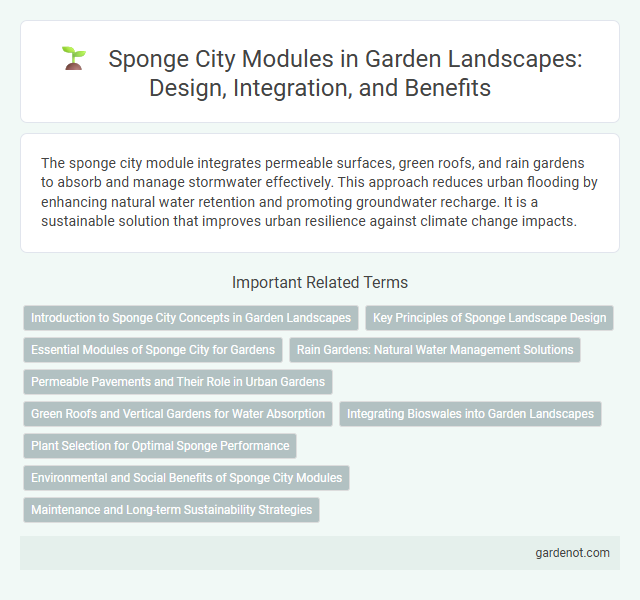The sponge city module integrates permeable surfaces, green roofs, and rain gardens to absorb and manage stormwater effectively. This approach reduces urban flooding by enhancing natural water retention and promoting groundwater recharge. It is a sustainable solution that improves urban resilience against climate change impacts.
Introduction to Sponge City Concepts in Garden Landscapes
Sponge city modules integrate permeable surfaces and green infrastructure to enhance urban water absorption and reduce runoff in garden landscapes. These systems mimic natural hydrological processes by incorporating rain gardens, bioswales, and porous pavements, increasing groundwater recharge and mitigating flood risks. Implementing sponge city concepts promotes sustainable urban drainage and improves ecological resilience within garden environments.
Key Principles of Sponge Landscape Design
Sponge landscape design integrates principles of water absorption, retention, and gradual release to mitigate urban flooding and enhance groundwater recharge. It prioritizes permeable surfaces, green infrastructure, and natural vegetation to manage stormwater sustainably. This approach creates resilient urban ecosystems that improve water quality and reduce environmental stress caused by heavy rainfall.
Essential Modules of Sponge City for Gardens
Sponge city modules for gardens emphasize permeable pavements, rain gardens, and bio-swales to enhance water absorption and retention. These essential modules reduce surface runoff, filter pollutants, and replenish groundwater, promoting urban resilience against flooding. Integrating vegetation buffers and storage facilities maximizes ecological benefits and supports sustainable landscape management.
Rain Gardens: Natural Water Management Solutions
Rain gardens in sponge city modules act as vital natural water management solutions by capturing and filtering stormwater runoff through layered soil and vegetation. These gardens reduce urban flooding, improve groundwater recharge, and enhance water quality by removing pollutants before water infiltrates the ground. Implementing rain gardens supports sustainable urban drainage systems and contributes to resilient, climate-adaptive city landscapes.
Permeable Pavements and Their Role in Urban Gardens
Permeable pavements in sponge city modules enhance urban gardens by allowing rainwater to infiltrate the soil, reducing surface runoff and mitigating flood risks. These pavements improve water retention, support plant health, and promote sustainable groundwater recharge in densely populated areas. Integrating permeable materials with urban green spaces fosters resilient ecosystems and efficient stormwater management.
Green Roofs and Vertical Gardens for Water Absorption
Green roofs and vertical gardens serve as essential components of sponge city modules, significantly enhancing urban water absorption and reducing runoff. These bio-retentive systems capture rainfall, promote infiltration, and improve microclimates by retaining water in plant substrates and soil layers. Integrating green roofs and vertical gardens within urban infrastructure increases stormwater management efficiency and supports sustainable city resilience against flooding.
Integrating Bioswales into Garden Landscapes
Integrating bioswales into garden landscapes within the Sponge City module enhances stormwater management by naturally filtering runoff and reducing urban flooding. These vegetated channels are designed with native plants and permeable soils, promoting groundwater recharge and improving water quality. Efficient bioswale integration supports sustainable urban environments by combining aesthetic appeal with functional landscape architecture.
Plant Selection for Optimal Sponge Performance
Selecting native, drought-tolerant plants with deep root systems enhances the sponge city module's water absorption and filtration capabilities. Species such as sedges, rushes, and willows improve soil permeability and reduce runoff by stabilizing soil and promoting infiltration. Integrating diverse plant communities tailored to local climate maximizes the sponge effect, supporting sustainable urban water management.
Environmental and Social Benefits of Sponge City Modules
Sponge city modules enhance urban water management by absorbing and filtering rainwater to reduce flooding and improve groundwater recharge. These systems promote biodiversity by creating green spaces that support local ecosystems and provide cleaner air. They also foster social well-being through improved recreational areas and increased community resilience against climate impacts.
Maintenance and Long-term Sustainability Strategies
Sponge city modules require regular inspection and cleaning of permeable surfaces and drainage systems to prevent clogging and maintain optimal water absorption. Incorporating native vegetation and adaptive plant species reduces maintenance needs and enhances ecosystem resilience. Long-term sustainability strategies involve integrating smart monitoring technologies to track water quality and soil moisture, ensuring efficient performance and timely interventions.
Sponge city module Infographic

 gardenot.com
gardenot.com